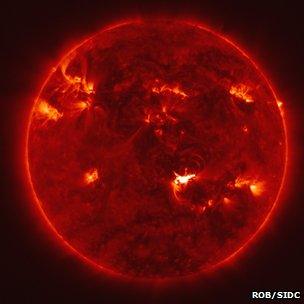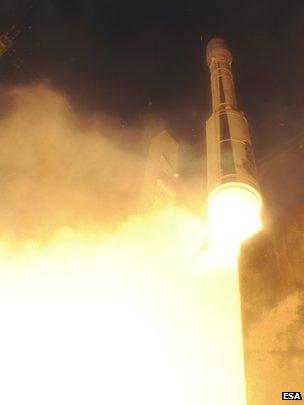Esa to start mini space mission series
- Published

Belgium's Swap instrument has been taking images of the Sun since 2009
The European Space Agency is starting what it expects to become a regular series of small science missions.
The first winning"S-Class", externalidea will receive 50 million euros (£42m) and will be readied for launch in 2017.
It is a departure for the organisation that is used to spending hundreds of millions of euros on flagship planetary probes and space telescopes.
Esa hopes particularly to encourage young scientists and research teams from smaller member states.
"We see a dearth of people being trained in space science in satellites, and this can pick those people up and help bring them on so that by the time they get to work on some of our big missions they already have experience," said Prof Mark McCaughrean, head of Esa's Research and Scientific Support Department.
"Also, it gives our smaller member states the opportunity to lead missions, which is something that is very difficult for them to do. The 'big four' (France, Germany, Italy, UK) have no problem, but it is harder for the likes of Spain, Sweden and Switzerland.
"We want to hear from innovative people who've got a clever idea that doesn't need a billion or half a billion euros, but can be done with a much smaller amount."
Interested parties will have to move fast, however. Expressions of interest must be submitted by 23 March, followed by a defined proposal in June.
A clutch of the best ideas will probably be selected for study in November, with a winner chosen for implementation 12 months after that.
There is no directive on what an S-Class mission should do, other than it fit within Esa's "Cosmic Vision" - the strategy document that governs all the agency's space science endeavours and which covers fundamental, but fairly broad, themes about the Universe and our place within it.

S-Class missions would probably launch on Esa's new small satellite launcher, Vega
Although Esa will be contributing 50m euros, the national governments of winning scientists will almost certainly be backing the projects as well, perhaps funding the cost of instrument development.
Even so, the "fast and small" nature of the S-Class philosophy means it is unlikely that we will see highly sophisticated and complex projects such as deep-space probes or Mars landers.
More realistic mission concepts could include compact space telescopes to look at very particular phenomena in the sky, or perhaps fundamental physics experiments that need to be done in the weightless environment of Earth orbit.
A good example might be the 8m-euro Lares (Laser Relativity Satellite, external) spacecraft launched in February on Esa's new Vega rocket.
This 37cm-diameter sphere developed by the Italian space agency (Asi) looks akin to a hi-tech "disco ball". It features 92 reflectors on its surface and is being used to make very precise laser ranging measurements from Earth.
Its purpose is to study "frame-dragging", one consequence of general relativity that describes how the Earth twists local space-time around with it as it rotates.
Another example is Esa's own Proba-2 satellite. This small platform was sent up principally to test new space technologies, but it incorporates an imager from Belgium calledSwap, externalthat is taking scientifically very useful pictures of the Sun.
Swap was in action last week, tracking the solar storm that hurled billions of tonnes of plasma at Earth.
In complete contrast, Esa is about to select its next large, or "L-Class", mission.
Three ideas are competing: a big X-ray telescope, a probe to Jupiter and its moons, and another - but much grander - general relativity experiment to detect gravitational waves. The total cost of the winning concept is likely to be in the region of a billion euros.
Jonathan.Amos-INTERNET@bbc.co.uk and follow me onTwitter, external
- Published13 February 2012
- Published4 October 2011